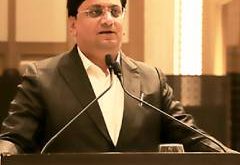In 2001, Iris Unified Management Limited was set up by Navin Kapur and his three partners to provide corporate training services. It was the time when technology was just being adopted by the Indian enterprise and the field of Consultancy & Training offered a huge scope. Iris had a sizeable business running in the training vertical, so the company branched out into providing end to end solutions. His primary focus was on infrastructure and his biggest clients were brands like Microsoft, Adobe, Symantec, Trend Micro & Juniper.
In 2011, it was a Rs.50 crores company , and on the path of expansion, Navin and his partners decided to raise funds and chose Comparex, a global company based out of Germany as a partner with stake. As a result, by 2011 the company grew to $1.5billion and presently they are worth $2 billion.
“Today we have 10 branches across the country, providing solutions to enterprises in the BFSI vertical.  Our principals are Microsoft, Oracle, IBM, Adobe, Symantec. The journey has been very exciting and in 2011 my three partners decided to separate. We went through another restructuring with Iris’ stake being 30% and Comparex having a 70% stake holder. That’s how Comparex’ journey started,” says Navin Kapur, Managing Director, Comparex India.
Our principals are Microsoft, Oracle, IBM, Adobe, Symantec. The journey has been very exciting and in 2011 my three partners decided to separate. We went through another restructuring with Iris’ stake being 30% and Comparex having a 70% stake holder. That’s how Comparex’ journey started,” says Navin Kapur, Managing Director, Comparex India.
Earlier operations Iris was constrained by size and could not go beyond a certain deal volume, but the partnership with Comparex helped in acquisition of multi-crores deals, enabling us to reach large enterprise customers with deeper pockets.
Navin shares with us the experience of the transitional phase for the company – the growth pangs of a smaller domestic company’s expansion to a global market..
- What is the present focus of company?
We believe in providing a complete solution to our customer. Today the biggest transformation in IT is adopting the cloud. In their journey to an efficient adoption, we feel customers need better consulting support to make informed decisions on the right technologies and processes to invest in. their planning needs to be on optimal usage of resources and ROI. So our first focus is to provide solutions that guide our clients on the optimal licensing choices. Since clients are our first priority, we are focusing and investing heavily in the cloud environment and aligning with the best in class comprehensive cloud solutions vendors. In our conversations with our customers, we help them decide on public, private or hybrid or even onsite clouds, share the comparative scenarios and all solutions that they can consider,
Enterprises today are focused on ROI. The CIO and the CFO need to show a business case for cloud adoption. Today the strongest case for cloud is that it allows the companies to move from a CAPEX to OPEX model. CFOs need to take a critical call on cloud adoption because once they move to OPEX, they need to be clear on how much they are paying per use. So, essentially. Our role is to provide the best fit solution to each of our customers, after understanding their specific business requirements and allowances.
- What all solutions you are offering to enterprises ?
Our focus is on Infrastructure support, and within it we are providing cloud, storage and security solutions. We create and offer customized solutions based on the clients’ business needs and budget. Once they invest, most enterprises plan for at least a three year window, so accordingly we ensure that they get scalable, agile solutions which they can upgrade if the business need arises.
We have noticed that in the BFSI vertical and most public sector units are slow to adopt the cloud due to the challenge inherent in their businesses. On the other hand, especially for our market – companies in the mid size market and SMBs, mostly enterprises with CAPEX issues prefer to adopt cloud technology. We see a huge change ahead for Indian enterprise in terms of technology adoption, and we, I am happy to say, are prepared to leverage on that.
- Are you giving complete cloud solutions?
We offer specified solutions from an infrastructure point of view, and provide these with support from our aligned partners. So our offerings are cloud solutions along with applications from our partners. In most cases it means complete end to end solutions, since the gamut of our partners covers every requirement an enterprise may have.
- Which are the verticals you are targeting with your solutions?
Since we do not do vertical specific solutions, we constantly challenge ourselves to create innovative ones for our clients across verticals. In addition, we do an in-depth study and ascertain the best ft solution for any enterprise, irrespective of the vertical it operates in. The company’s IT stature, its rate and direction of transformation and of course, its business objective- we create solutions keeping these in the focus. Right now, we are looking at BFSI, Infrastructure, and manufacturing sectors, and expect manufacturing to be much more competitive after our new prime minister’s “Make in India” call.
In terms of revenue, almost 40% of our revenue comes from the manufacturing sector , 30% from IT and rest from BFSI, PSUs etc.
- How do you approach these verticals?
We essentially have a consultative approach. So, first we reach out to the decision makers, showcase our abilities and differentiators, then demonstrate our solutions after understanding their business needs, priorities and then discuss their real requirements. Based on this discussion, we offer our solutions.
All our work with the customer is completely transparent and so it is never a challenge to advise them about the right solution according to their business need.
- What are the challenges you are facing and how do overcome?
It’s a competitive world and we love competition. So while we do plan for offering new solutions to our customers, consistency is the real differentiator for our business. Indian markets are relationship driven and we offer our value on customer relationships. We advise on strategy, to key stakeholders, plan events present our services to them and also work on referral customers. We are always conscious of the fact that our biggest strength is our clear messaging to customers.
- Where do you see the growth coming from?
From North we have moved to different regions, from two offices we have moved to 10 offices. We are expanding our volume of business and our alignments with vendors has helped us grow in India, so toady we are more than capable of handling larger customers.
- Which are the cities where you get most of your business?
We get most of our business from metro cities. We have a presence in Delhi, Gurgaon, Chandigarh, Ludhiana, Ahmadabad, Mumbai, Chennai, Bangalore.
- What are your expansion plans?
This year we would want to expand in two more cities Kolkata, Cochin, and a few more.. Since last year was all about expansion, this year we plan to sustain the accounts we have acquired. We would be adding couple of technologies from IBM software, VMware and some of security products this year, as well.
 Latest Technology News Today – Get Latest Information Technology Updates and Services Latest Technology News Today – Get Latest Information Technology Updates and Services
Latest Technology News Today – Get Latest Information Technology Updates and Services Latest Technology News Today – Get Latest Information Technology Updates and Services 









